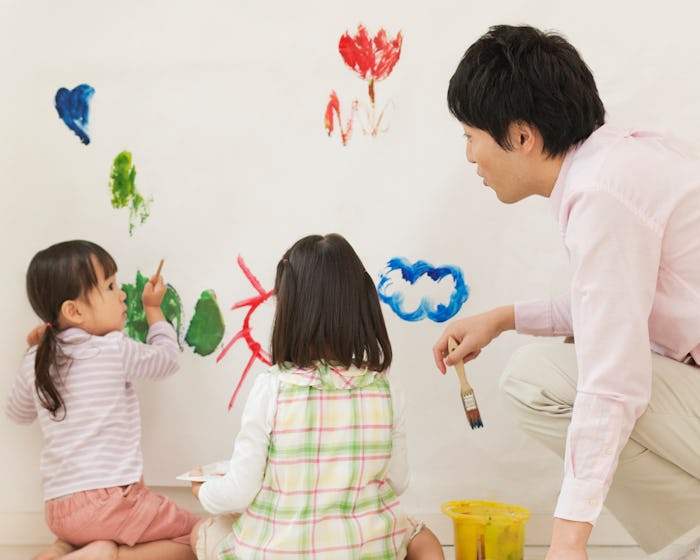Life

Here's How To Have Fun Painting A Mural In Your Home With The Whole Family
There it is, that big blank wall in your house you have no idea what to do with. Sure, you could hang a print or add a mirror, but learning how to paint a mural in your home with your kids would be a lot more fun, and just think of the memorable end result. Of course, like any project with your kids, you'll want to manage your expectations for what the process and the finished piece will be like.
First and foremost, if you're hoping to get a masterpiece out of a family-made mural, you're likely asking too much (unless you happen to have an art prodigy for a child). "Parent[s] and children should know their level of skill and what they are getting into" before diving into a mural, high school art teacher Kwang Joo tells Romper. Additionally, before deciding what you want to paint, Joo says you should consider where the wall is in the home as well as the texture of the surface so you know what type of paint will work best. Beyond that, he suggests going into the project "know[ing] your budget and your patience level."
If you don't have a spot in the house already picked out for a mural project, consider a wall in your child's room. "The location of the mural is important," he says. Everyone should be able to enjoy the process and the result." Choosing a spot in your child's room will get them really excited about the project, particularly if you pick a design or character they love. Once you have that figured out (and before you bust out the paint brushes), Joo recommends doing a few practice runs by having you and your child sketch out what you're planning to eventually put up on the wall. Then, after you've mastered your sketch, determine if you want to project it onto the wall to trace or freehand it (projecting it will make it much easier).
The prep may feel like it's taking forever to your child who is ready and waiting with a paintbrush in hand, so do it before getting them too excited about the process. You'll want to make sure you've put down (a lot of) drop cloths to protect your floor from inevitable drips and spills and have a pile of towels ready to wipe off mistakes. The Art of Education University suggests a color by number approach (giving each color a number, and labeling each section of the mural sketch with that number) to help keep things organized. You can also use a similar method to assign different sections or colors if you have multiple kids working on the project.
You'll also want to have paint picked out, purchased, and ready to go (pro tip: put the paint in a small painters cup with a handle that's easy for your child to hold without spilling). If you're planning on using regular wall paint for the mural, try to purchase one that's non-VOC. VOCs (volatile organic compounds) are gasses "which may have short and long-term adverse health effects," according to the EPA. VOCs are found in a lot of products you use every day, but it's not the small exposure here and there that you need to worry about, it's extended exposure, particularly in unventilated spaces. There are a lot of great non-VOC paint options like ECOS Paints, and some larger brands like Behr, Benjamin Moore, and Sherwin Williams also have options.
Put the kids in some paint clothes and have them do some practice brush strokes before diving in, too. Haring Kids suggests letting your little ones try out different brushes (or you can use sponges or even cotton balls with clothespins, like Project Nursery suggests) to see what works for them and to get a feel for how to paint with (their version of) precision. Then, once you're ready to go, let the kids have at it. You may be tempted to try to control every aspect of the mural, but Joo recommends parents a more hands-off approach. "Keep it simple, be flexible, [and be] ready for an unexpected outcome," he says.
In order to make this project the most fun it can be, parents shouldn't be too focused on what the final picture will look like (if that's what matters, it's better to DIY or hire it out). "Excitement is in the process, not the result," he says. "You will make lots of mistakes, you will fail many times but as long as [you and the kids] appreciate each of those moment together, it will be great art." In fact, he says he once visited a home that had a family-made mural and the kids "loved it and explained every detail of how they did it... it made them happy!"
Worst-case scenario: In the end, you all agree your mural is not the greatest piece of art ever. As long as you had fun painting it, you'll be able to laugh about the outcome rather than feel defeated or frustrated. Your finished mural will be a direct result, and semi-permanent reminder, of your experience with the kids. Walking past a wall full of flaws and fun memories will beat out an impersonal perfect masterpiece every time.
Expert:
Kwang Joo, Art Teacher at Wake Young Men's Leadership Academy in Raleigh, North Carolina